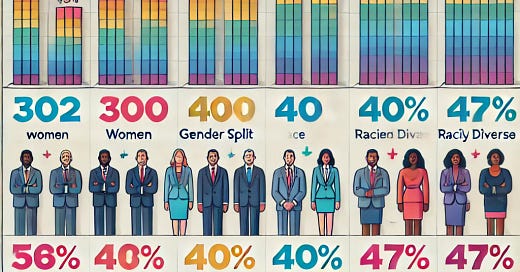Who are the most influential gay men and women in Corporate America?
The Pride 2024 list of the 41 LGBT Fortune 500 Board members is out. LGBTQ+ people occupy less than 1% of all Fortune 500 Board Seats; less than 10% of F500 companies have an LGBTQ+ Board Member
For the past three years (see 2022 and 2023 here), we have analyzed the LGBTQ+ representation in Fortune 500 ahead of the Annual Summit of the Association of Corporate Directors (taking place next Thursday in NYC).
It is a good indicator of the Association's progress and the increasing voice of LGBTQ+ leaders in the corporate world. A complete database is available below and will be included in the comprehensive 2024 Board Monitor Report, which will be released next week (it also looks at the NASDAQ grouping progress).
Despite some Fortune 500 companies claiming they are “done with the diversity agenda,” the “all straight board” remains the norm in the leading companies in America, and LGBTQ+ representation on Boards between departures (Ralph Lauren, which has a rather queer board (see page 40 of their proxy), is now ranked 544 in the Fortune list) and two new seats (congratulations to Audrey Choi (3M) and Jan Siegmund (Marsh McLennan)) is progressing very slowly.
As of 2024, 47 board seats—out of over 5,400 available (Fortune estimate)—are occupied by LGBTQ+ individuals, representing 0.9% of all board seats. This slightly improved compared to the 0.74% we reported in 2023. While some new appointments have nudged the needle forward, the real change comes from better information on who is LGBTQ+ in the boardroom. Some companies and individuals have left (e.g., Ralph Lauren is now 544, Barry Diller famously retired from the Coca-Cola Board, and Jeff Gennette is no longer at Macy’s). We have kept our denominator to an estimated 5,400 Board seats in Fortune 500 companies.
LGBTQ+ people occupy 0.9% of all Fortune 500 Board Seats; less than 10% of Fortune 500 companies have an LGBTQ+ Board Member
While LGBTQ+ individuals occupy 47 seats, this represents 41 individuals, as some serve on multiple boards.
Key Statistics and Insights
Gender Split: Women represent a significant share, occupying 60% of the LGBTQ+ board seats. This is much better than the Fortune 500 demographics, where women hold 30% of board seats. As of September 2024, there remains no known trans or non-binary representation on Fortune 500 boards.
60% of these seats are occupied by lesbians, more than 40% by non-white individuals
Race: 57% of the LGBTQ+ seats are occupied by white/Caucasian men and women, with the rest occupied by racially diverse candidates. This is greater diversity than the overall demographics of the Fortune 500, where 77.8% of seats are occupied by white Board members, showing the power of intersectionality in LGBTQ+ talent.
Industry Breakdown: Most LGBTQ+ directors work in industries such as technology, financial services, and healthcare, with notable representation in retail.
Background: 38% of these seats are occupied by financial specialists.
Geography: As in previous years, LGBTQ+ representation is concentrated in New York and California, with over 40% of seats held in these states.
Average Age: The average age of these board members is 60, indicating that, like much of corporate America, LGBTQ+ representation remains skewed towards those later in their careers. According to Fortune, the average age of an S&P 500 board member was 63.1 in 2023, suggesting LGBTQ+ Board members might be slightly younger.
Tenure: The average tenure for LGBTQ+ board members is about 6.5 years, a little lower than the wider Fortune 500 board population. This shows that LGBTQ+ people are relatively recent appointees. Nancy M. Schlichting and Tim Cook win the longevity palm with, respectively, 18 years on the Walgreens Board and 13 years on the Apple Board.
Educational Background: Most LGBTQ+ board members hold degrees from prestigious institutions like Harvard, Stanford, and MIT.
The All-Straight Boards Still Predominate
Despite vocal commitments to diversity, several leading companies—especially in tech and finance—still lack LGBTQ+ board representation. Amazon, Airbnb, Bank of America, IBM, Microsoft, and Procter & Gamble stand out as companies with ubiquitous "all straight boards" despite their high scores on the Human Rights Campaign's Corporate Equality Index.
Conclusion
As we inch forward, the number of LGBTQ+ individuals on corporate boards is still well below what true representation should be: LGBTQ+ Identification in the U.S. is now at 7.6%, according to the annual Gallup survey. Progress is made boardroom by boardroom, but the day when LGBTQ+ individuals are as present and visible at the board level as they are throughout society remains far off.
It makes the case for our work. In 2024, the Association of LGBTQ+ Corporate Directors sparked conversations that drove the adoption of LGBTQ+ inclusive policies and disclosures in Fortune 500 companies and gave visibility to the LGBTQ+ boardroom talent. The call to action for companies to continue diversifying and including LGBTQ+ voices at the highest levels of governance remains critical.
This 0.9% representation figure must be compared to 7.6% of all Americans identifying as LGBTQ+.
The full database
The nominative database below might contain mistakes; you can contact me if you identify any.
Keep reading with a 7-day free trial
Subscribe to Fabrice Houdart | A weekly newsletter on LGBTQ+ Equality to keep reading this post and get 7 days of free access to the full post archives.



